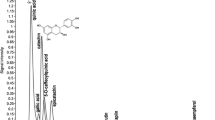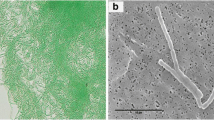Abstract
Cyanobacteria, can be found in many different terrestrial or aquatic habitats that are sometimes unbearable for many other organisms. Biosynthesis of mycosporine-like amino acids (MAAs) enables growth in such environments due to their UV screening and antioxidant activity. MAAs are water-soluble bioactive molecules with vast biotechnological potentials due to their UV screening properties and antioxidant activities. In the present study, the occurrence of MAAs in the cyanobacterium Leptolyngbya sp. (Gomont) Anagnostidis and Komárek was assessed by HPLC–PDA ESI–MS analysis. The combination of UV and MS data values revealed the occurrence of nine different MAAs, including; palythine (1), palythenic acid (2), euhalothece-362 (3), palythene (4), usujirene (5), palythine serine (6), asterina-330 (7), palythinol (8), and palythine-threonine (9). As well, some different in vitro antioxidant assays such as ABTS, FRAP, and RP were applied to evaluate the antioxidant properties of the MAA-enriched extract. The results indicate a significant and dose-dependent antioxidant activity of the MAA-enriched extract (54% ABTS scavenging activity at the dose of 2 mg mL−1 extract) in this cyanobacterium which was comparable with those of ascorbic acid (81% antioxidation rate at 2 mg mL−1 of ascorbic acid). All these observations suggest that Leptolyngbya sp. may act as a new, promising source of MAA compounds.







Similar content being viewed by others
Abbreviations
- HPLC:
-
High-performance liquid chromatography
- MAAs:
-
Mycosporine-like amino acids
- RT:
-
Retention time
- UV-B:
-
Ultraviolet-B
References
Arnao MB, Cano A, Acosta M (2001) The hydrophilic and lipophilic contribution to total antioxidant activity. Food Chem 73:239–244
Benzie IF, Strain JJ (1996) The ferric reducing ability of plasma (FRAP) as a measure of “antioxidant power”: the FRAP assay. Anal Biochem 239:70–76
Carocho M, Ferreira IC (2013) A review on antioxidants, prooxidants and related controversy: natural and synthetic compounds, screening and analysis methodologies and future perspectives. Food Chem Toxic 51:15–25
De la Coba F, Aguilera J, Figueroa F, De Gálvez M, Herrera E (2009) Antioxidant activity of mycosporine-like amino acids isolated from three red macroalgae and one marine lichen. J Appl Phycol 21:161–169
Evangelista V (2008) Algal toxins: nature, occurrence, effect and detection. Springer Science & Business Media
Geraldes V, Jacinavicius FR, Genuario DB, Pinto E (2019) Identification and distribution of mycosporine-like amino acids in Brazilian cyanobacteria by UHPLC-DAD-QTOF. Rapid Commun Mass Spectrom. https://doi.org/10.1002/rcm.8634
Gröniger A, Sinha R, Klisch M, Häder D-P (2000) Photoprotective compounds in cyanobacteria, phytoplankton and macroalgae—a database. J Photochem Photobiol B Biol 58:115–122
Gulcin I (2015) Fe(3+)-Fe(2+) transformation method: an important antioxidant assay. Methods Mol Biol 1208:233–246
Jain S, Prajapat G, Abrar M, Ledwani L, Singh A, Agrawal A (2017) Cyanobacteria as efficient producers of mycosporine-like amino acids. J Basic Microbiol 57:715–727
Karsten U, Sawall T, West J, Wiencke C (2000) Ultraviolet sunscreen compounds in epiphytic red algae from mangroves. Hydrobiologia 432:159–171
Katoch M, Mazmouz R, Chau R, Pearson LA, Pickford R, Neilan BA (2016) Heterologous production of cyanobacterial mycosporine-like amino acids mycosporine-ornithine and mycosporine-lysine in Escherichia coli. Appl Environ Microbiol 82:6167–6173
Kulkarni A, Lee JH, Seo HH, Kim HS, Cho MJ, Shin DS, Kim T, Moh SH (2015) Photoinduced conductivity in mycosporine-like amino acids. Mater Chem Phys 151:1–4
Long LH, Chua Thiam Kwee D, Halliwell B (2000) The Antioxidant activities of seasonings used in Asian cooking. Powerful antioxidant activity of dark soy sauce revealed using the ABTS assay. Free Radic Res 32:181–186
Morone J, Alfeus A, Vasconcelos V, Martins R (2019) Revealing the potential of cyanobacteria in cosmetics and cosmeceuticals—a new bioactive approach. Algal Res 41:101541
Nazifi E, Wada N, Asano T, Nishiuchi T, Iwamuro Y, Chinaka S, Matsugo S, Sakamoto T (2015) Characterization of the chemical diversity of glycosylated mycosporine-like amino acids in the terrestrial cyanobacterium Nostoc commune. J Photochem Photobiol B Biol 142:154–168
Oren A, Gunde-Cimerman N (2007) Mycosporines and mycosporine-like amino acids: UV protectants or multipurpose secondary metabolites? FEMS Microbiol Lett 269:1–10
Oyaizu M (1986) Studies on products of browning reaction: antioxidative activity of products of browning reaction. Jpn J Nutr 40:307–315
Radice M, Manfredini S, Ziosi P, Dissette V, Buso P, Fallacara A, Vertuani S (2016) Herbal extracts, lichens and biomolecules as natural photo-protection alternatives to synthetic UV filters. A systematic review. Fitoterapia 114:144–162
Rastogi RP, Incharoensakdi A (2013) UV radiation-induced accumulation of photoprotective compounds in the green alga Tetraspora sp. CU2551. Plant Physiol Biochem 70:7–13
Rastogi RP, Incharoensakdi A (2014) UV radiation-induced biosynthesis, stability and antioxidant activity of mycosporine-like amino acids (MAAs) in a unicellular cyanobacterium Gloeocapsa sp. CU2556. J Photochem Photobiol B Biol 130:287–292
Rastogi RP, Sonani RR, Madamwar D, Incharoensakdi A (2016) Characterization and antioxidant functions of mycosporine-like amino acids in the cyanobacterium Nostoc sp. R76DM. Algal Res 16:110–118
Sb AG, Sharma K, Kumar S, Sharma A, Purohit AP (2011) Mycosporine and mycosporine-like amino acids: a paramount tool against ultra violet irradiation. Pharmacogn Rev 5:138–146
Shick JM, Dunlap WC, Pearse JS, Pearse VB (2002) Mycosporine-like amino acid content in four species of sea anemones in the genus Anthopleura reflects phylogenetic but not environmental or symbiotic relationships. Biol Bull 203:315–330
Shukla V, Kumari R, Patel DK, Upreti DK (2016) Characterization of the diversity of mycosporine-like amino acids in lichens from high altitude region of Himalaya. Amino Acids 48:129–136
Singh SP, Häder DP, Sinha RP (2010) Cyanobacteria and ultraviolet radiation (UVR) stress: mitigation strategies. Ageing Res Rev 9:79–90
Sinha RP, Klisch M, Hader DP (1999) Induction of a mycosporine-like amino acid (MAA) in the rice-field cyanobacterium Anabaena sp. by UV irradiat. J Photochem Photobiol B Biol 52:59–64
Sun Y, Zhang N, Zhou J, Dong S, Zhang X, Guo L, Guo G (2020) Distribution, contents, and types of mycosporine-like amino acids (MAAs) in marine macroalgae and a database for MAAs based on these characteristics. Mar Drugs. https://doi.org/10.3390/md18010043
Taira H, Aoki S, Yamanoha B, Taguchi S (2004) Daily variation in cellular content of UV-absorbing compounds mycosporine-like amino acids in the marine dinoflagellate Scrippsiella sweeneyae. J Photochem Photobiol B Biol 75:145–155
Torres PB, Chow F, Ferreira MJP, dos Santos DYAC (2015) Mycosporine-like amino acids from Gracilariopsis tenuifrons (Gracilariales, Rhodophyta) and its variation under high light. J Appl Phycol 28:2035–2040
Trabelsi L, Mnari A, Abdel-Daim MM, Abid-Essafi S, Aleya L (2016) Therapeutic properties in Tunisian hot springs: first evidence of phenolic compounds in the cyanobacterium Leptolyngbya sp. biomass, capsular polysaccharides and releasing polysaccharides. BMC Complement Altern Med 16:515
Volkmann M, Gorbushina AA (2006) A broadly applicable method for extraction and characterization of mycosporines and mycosporine-like amino acids of terrestrial, marine and freshwater origin. FEMS Microbiol Lett 255:286–295
Wada N, Sakamoto T, Matsugo S (2015) Mycosporine-Like Amino Acids and their derivatives as natural antioxidants. Antioxidants 4:603–646
Yuan YV, Westcott ND, Hu C, Kitts DD (2009) Mycosporine-like amino acid composition of the edible red alga, Palmaria palmata (dulse) harvested from the west and east coasts of Grand Manan Island, New Brunswick. Food Chem 112:321–328
Acknowledgements
This work was supported by National Institute for Medical Research Development, Grant no. 940709.
Author information
Authors and Affiliations
Corresponding author
Ethics declarations
Conflict of interest
The authors declare that no conflicting interests exist.
Ethical approval
This article does not contain any studies with animals performed by any of the authors.
Additional information
Communicated by P. Wojtaszek.
Publisher's Note
Springer Nature remains neutral with regard to jurisdictional claims in published maps and institutional affiliations.
Rights and permissions
Springer Nature or its licensor holds exclusive rights to this article under a publishing agreement with the author(s) or other rightsholder(s); author self-archiving of the accepted manuscript version of this article is solely governed by the terms of such publishing agreement and applicable law.
About this article
Cite this article
Kokabi, M., Yousefzadi, M., Nejad Ebrahimi, S. et al. Evaluating the photoprotective potential of Leptolyngbya sp.. Acta Physiol Plant 44, 94 (2022). https://doi.org/10.1007/s11738-022-03416-4
Received:
Revised:
Accepted:
Published:
DOI: https://doi.org/10.1007/s11738-022-03416-4




